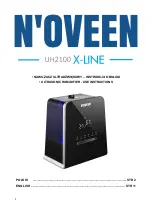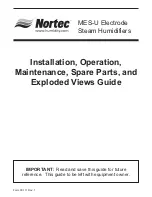
has some light carbon deposits, the burn out occurred
while the compressor was not rotating. Contaminants are
therefore largely confined to the compressor housing. A
single installation of liquid and suction line filter/driers will
probably clean up the system.
If sludge is evident in the discharge line, it will likely be found
in the suction line. This indicates the compressor burned out
while running. Sludge and acid has been pumped throughout
the system. Several changes of the liquid and suction filter/
driers will probably be necessary to cleanse the system.
5. Correct the system fault that caused the burn out. Consult
the factory for advice.
6. Install the replacement compressor with a new capacitor
and an oversized liquid line filter. In a running burn
out, install an oversized suction line filter/drier between
the accumulator and compressor. Thoroughly flush the
accumulator with refrigerant to remove all trapped sludge
and to prevent the oil hole from becoming plugged. A
standing burn out does not require a suction line filter/drier.
7. Evacuate the system with a good vacuum pump and
accurate vacuum gauge. Leave the pump on the system for
at least an hour.
An alternate method of removing moisture and non-
condensibles from the system requires evacuation to 29” Hg
vacuum. Then break the vacuum with 35 to 50 PSIG refrigerant
vapor charge. Leave the vapor charge in the system from at
least 5 minutes before removing it. Repeat the vapor charge/
wait/remove sequence twice more and then charge the system
with the quantity and refrigerant listed on the nameplate.
8. Operate the system for a short period of time, monitoring
the suction pressure to determine that the suction filter
is not becoming plugged. Replace the suction filter/drier
if pressure drop occurs. If a severe running burn out has
occurred, several filters/driers may have to be replaced to
remove all of the acid and moisture.
NOTE: NEVER
use the compressor to evacuate the system or any
part of it.
5.6C Replacing a Compressor - Nonburn Out
Remove the refrigerant from the system. Replace the compressor
and liquid line filter/drier. Charge the system to 50 PSIG and
check for leaks. Remove the charge and weigh in the refrigerant
quantity listed on the nameplate. Operate they system to verify
performance.
5.7 Humidity Control
The humidity control is an adjustable switch that closes when the
relative humidity of the air in which it is located rises to the dial
set point. It opens when the RH drops 4 to 6% below the set point.
5.8 Defrost Thermostat
The defrost thermostat is attached to the refrigerant
suction tube between the accumulator and compressor. It will
automatically shut the compressor off if the low side
refrigerant temperature drops due to excessive frost
formation on the evaporator coil. The blower will continue
to run, causing air to flow through the evaporator coil and melt the
ice. When the ice has melted, the evaporator
temperature will rise and the thermostat will restart the
compressor.
5.9 Condensate Pump
Condensate is automatically pumped to a remote location when
the water level in the pump’s reservoir rises to close the float
switch.
SANTA FE INSTALLER'S AND OWNER'S MANUAL
6
Santa Fe Installer’s & Owner’s Manual
7
Santa Fe Installer’s & Owner’s Manual

































